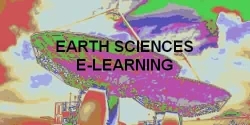Lake Vostok
Lake Vostok hidden beneath the ice of Antarctica
Lake Vostok is a huge lake beneath the Antacrtic ice, sealed off from the rest of the world for so long that it may contain unique evolved lifeforms.
Shown below :Microbes in ice above Lake Vostok
 click
for
larger
image
click
for
larger
image 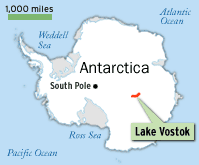
Lake Vostok is a large (10,000km2), presumably fresh water body located beneath four km of ice at 77oS105oE in East Antarctica. The lake is approximately 250km long and 50km wide, with depths ranging from 500-10m. The overlying ice provides a continuous paleoclimatic record of 400,000 years, although the lake may have been isolated for a much longer time. Because of the long isolation of this lake, it is believed that the water inside Lake Vostok could contain new lifeforms, and unique geochemical processes. For five years, scientists in Russia and the United States have sought to probe Vostok to discover the secrets lying inside this pristine body of water.
Image: ABC News: http://abcnews.go.com/sections/science/DyeHard/dyehard991215.html )

(For an impressive slide show on Lake Vostok, visit http://www.homepage.montana.edu/~lkbonney/DOCS/AAAS%20Prsentation.htm ) For a longer introduction to Lake Vostok and the issues, read this ASOC paper on options for Lake Vostok. So what's the problem? Well, basically the issue turns on the reality that it is impossible to penetrate an isolated ecosystem without contaminating it. The catch 22 inherent in Lake Vostok is that the very thing that make it potentially unique: its millenia of isolation from the rest of the world, cannot be explored without introduction of the outer world to Lake Vostok.
For instance, NASA, the US Space Agency, has expressed interest in penetrating Lake Vostok to search for microbes that might be similar to ones on other planets. According to NASA's Chric Mackay, "How the bacteria get energy (to survive) is an important question. The lake could be an analog to sub-ice Europa or subsurface Mars where conditions are similar."(Divining Water on Europa) Can we penetrate Lake Vostok without disturbing the water? (**webmaster note: drilling has indeed been very difficult and contamination an issue**)
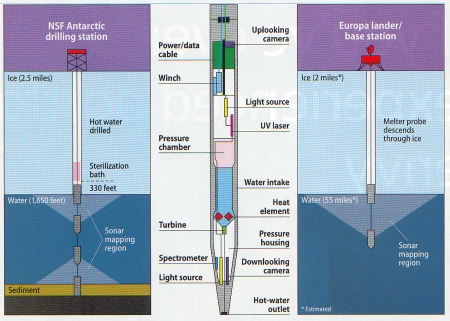
For several years, Russia has planned to penetrate the lake, but ASOC, and others, have forced the delay of the project until 2003-2004, awaiting the writing of a Comprehensive Environmental Assessment (CEE) of the project. Russia has promised to submit a CEE for review by the Parties at ATCM XXVI in Madrid, June, 2003.
Can this be done safely, without endangering the Environment? Are we rushing to drill into Lake Vostok without considering all the alternatives? Once the lake is penetrated, it will be impossible to pretend that the water is still isolated. What's the rush? Lake Vostok has sat untouched for millenia, another couple of years to ensure the protection of this unique resource won't hurt.
ASOC Papers on Lake Vostok: ASOC Position on Recent Developments in Subglacial Lake Exploration (Excerpt from ASOC Report to XXV ATCM, Warsaw, Poland, 2002) Applying Environmental Impact Assessment to Lake Vostok (ASOC 2001 Paper, SALE GOS Workshop, The Hague) Options for Lake Vostok
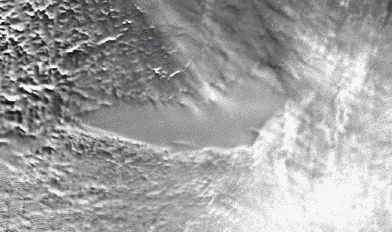
radar image of Lake Vostok
 click for
larger image
click for
larger imageMore than 70 lakes have been identified beneath the thick Antarctic ice sheet from ice-penetrating radar (Siegert et al., 1996). Most of these lakes, captured between 3-4 kilometers of ice, are several kilometers long and are primarily located beneath the major ice divides. One of these lakes, Lake Vostok, is an order of magnitude larger than others.
This lake is a large system and represents the closest analogue to Europa the ice covered Jovian moon and to a Neoproterozoic subglacial environment. Lake Vostok was identified in 1996 by Russian and British scientists (Kapitsa et al., 1996) who integrated data ranging from down-hole seismics, star observations and airborne ice-penetrating radar to new spaceborne altimetric observations.
The horizontal extent of the lake is estimated from the flat surface (0.01 degrees) observed in the ERS-1 ice surface altimetry. The 4-kilometer-thick ice sheet goes afloat as it crosses the lake, just as ice sheets become floating ice shelves at the grounding line. The subglacial environment represents one of the most oligotrophic environments on Earth, an environment with low nutrient levels and low standing stocks of viable organisms. If life thrives in the environments it may have to depend on alternative energy sources and survival strategies. A flash animation illustrates the basal freezing process and the flow of the ice sheet over the lake: (Vostok Flash Animation
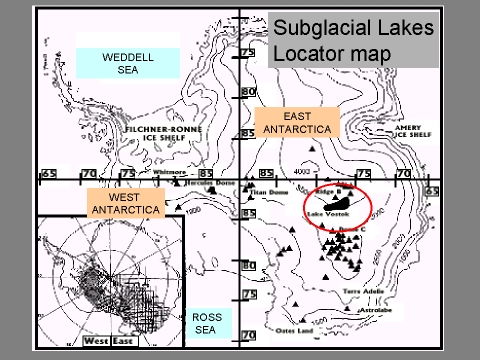 click for larger image
click for larger imageLos Angeles Times article on Lake Vostok On March 4, 2001, the LA Times printed an article about Lake Vostok on the front page. Reprint of the article on the Columbia Earth Institute web page.
Science and Science News articles on Lake Vostok On March 3, 2001, Science Magazine and Science News featured articles about Lake Vostok. Science article by Robert Irion. Science News article.
Geotimes article on Lake Vostok East Antarctica played opossum. Article by Christina Reed.
Scientific American article on Lake Vostok Out in the cold. Scientific American article by Wayt Gibbs.
NSF workshop on Lake Vostok Lake Vostok: A Curiosity or a Focus for Interdisciplinary Study?
Workshop in Washington D.C., November 7-8, 1998.
sponsored by the National Science Foundation (NSF). Workshop report by Robin E. Bell and David M. Karl.
SCAR workshop on Lake Vostok Sub-Glacial Lake Vostok: Science Opportunities and Technological Challenges.
Workshop in Cambridge (UK), September 26-27, 1999.
sponsored by the Scientific Committee on Antarctic Research (SCAR). Workshop program by Cynan Ellis-Evans. NSF news release on Lake Vostok On August 3, 1999, NSF's Office of Legislative and Public Affairs announced a news release on Lake Vostok. NSF News Release on Lake Vostok.
BBC news release on Lake Vostok On September 27, 1999, BBC announced a news release on Lake Vostok. BBC News Release on Lake Vostok.
Science News article on Lake Vostok On October 2, 1999, Science News published an article about Lake Vostok and the SCAR workshop. Science News article on Lake Vostok.
JPL/NASA Europa/Lake Vostok Initiative The JPL/NASA site contains a space perspective on Lake Vostok. The JPl/NASA Europe/Vostok Initiative .
Space.com news release on Lake Vostok.
A biological perspective on Lake Vostok.
Creatures that live in extreme environments has been refered to as extremeophiles to learn more click the link below...

